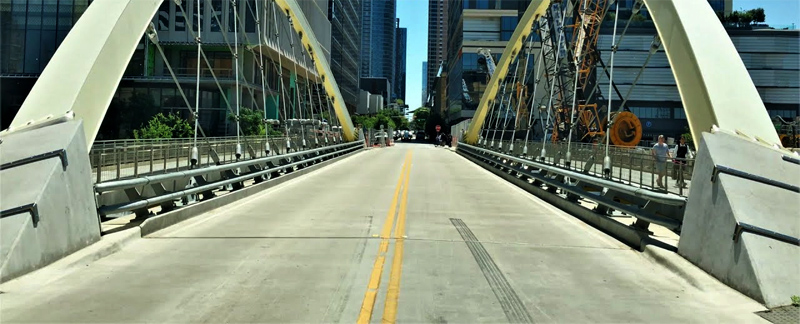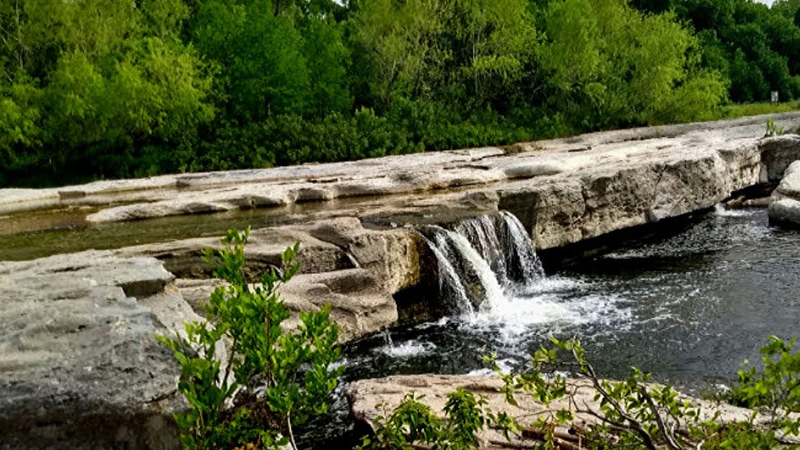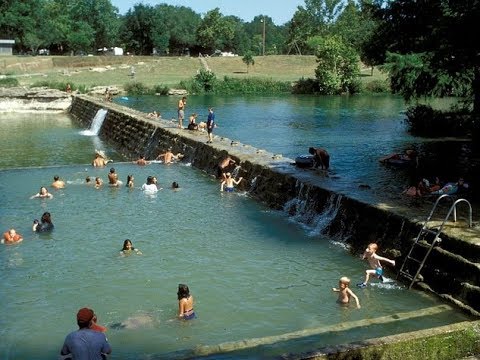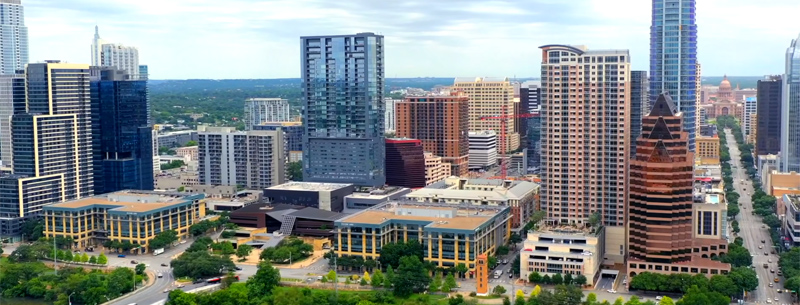Austin, in Travis County in Central Texas, is the capital of Texas and the fourth largest city in Texas. Austin was named after Stephen F. Austin, known as The Father of Texas. Austin is home to the University of Texas and the Texas Longhorns. Much of the atmosphere of Austin and its unofficial slogan, “Keep Austin Weird” is affected by the big student and professor population and the diversity that they bring to the town. Austin is also considered by many to be the “Live Music Capital of the World“. A person can’t walk the streets of Austin at any time without hearing the sound of live music in the background. Austin maintains a pretty comfortable temperature all year long. The summers are a little warmer than some people like but the winters are very mild.
Downtown Austin
Downtown Austin starts at Ladybird Lake (formerly Town Lake) and stretches past the Texas State Capitol Building and the University of Texas. The most famous section attraction in downtown Austin is Sixth Street. Sixth Street is divided into two separate districts; the entertainment district and the historic district. The entertainment district is home to much of the nightlife hot spots in Austin. This district is also the location for several festivals throughout the year.
The Sixth Street historic district, listed in the National Register of Historic Places. The community center in Austin hosts a periodic market day in which hundreds of vendors gather to sell their goods. This market usually has books, electronics, movies, games, clothes, and much more. In downtown Austin, you can also find many museums, great shopping, fine dining, and beautiful parks. downtown Austin offers a free bus system for getting around.

Attractions
Before you start your tour of Austin, stop by the Capitol Visitor Center. The Capitol Visitor Center is a great place to start planning your visit Austin. The visitor center also has Austin related exhibits, photos, and gift shop. The exhibits in the Capitol Visitor Center include Capitol TimeLine, an educational exhibit that explores the history of Texas, and Beyond the Dome, which explores the fewer know areas of Austin. The visitor center exhibits often change so you may get a different experience each time you go.
Texas State Capitol Building
The most famous Austin attraction is the Texas State Capitol Building. This building is one of the most distinguished buildings in Texas and is the biggest state capitol building in the United States. This building contains the offices of Texas legislators and the Governor of Texas. You can explore the building on your own or you can get a more comprehensive tour with one of the Capitol tour guides. You can also visit the Capitol gift shop to pick up your Texas souvenir.

Bat Bridge
If you are in Austin from March to October, do not miss the nightly bat bridge show. Every night at dusk hundreds of thousands of bats leave their home under the Congress Avenue Bridge to find food. This spectacular display is very unusual for an urban setting. Charter services are offered on Ladybird Lake to get a better view of the show.
Ladybird Lake
Ladybird Lake is a popular Austin attraction. City ordinances do not allow boating but the lake offers great fishing, swimming, and canoeing. A ten-mile long hiking and biking trail around the lake offers a great view of downtown Austin while getting some exercise. Ladybird Lake has several parks along its bank. One popular park on Ladybird Lake is Zilker Park. Zilker Park is a great park for picnicking or a family gathering. Zilker Park has a natural spring called Barton Springs. Barton Springs is a popular Ladybird Lake area swimming hole.

State Parks
Texas has almost 100 State parks, 5 of which are less than an hour from Austin. These six nearby State Parks are Guadalupe River State Park, McKinney Falls State Park, Palmetto State Park, Lockhart State Park, and Blanco State Park.
Guadalupe River State Park
Guadalupe River State Park, about 45 minutes from Austin, consists of about 1938 acres along the Guadalupe River. This area includes about 4 miles of river frontage. Guadalupe River State Park is most known for swimming, tubing, canoeing, kayaking, and fishing.
McKinney Falls State Park
McKinney Falls State Park, just outside of Austin, is a 744-acre park. This park features several miles of trails, the ruins of a historic house, the famous Smith Rock Shelter, and of course the beautiful McKinney Falls.

Palmetto State Park
Palmetto State Park is a 270-acre park located about an hour east of Austin. Palmetto State Park features campgrounds, a picnic pavilion, hiking trails, fishing, birding, nature study, swimming, tubing, canoeing, and pedal boat rentals. Palmetto State Park sites include an oxbow lake, the San Marcos River, an artesian well, and several species of tropical plants including the Dwarf Palmetto.
Lockhart State Park
Lockhart State Park located near Palmetto State Park about is a 263-acre State Park. This park includes several miles of hiking trails, a beautiful waterfall on Clear Fork Creek, and a 9-hole golf course.
Blanco State Park
Blanco State Park is a 104-acre park along the Blanco River near New Braunfels about 45 minutes from Austin. This park features great swimming areas around man-made waterfalls and huge camp areas with electricity.

Sports in Austin
Austin has no professional sports teams but the University of Texas Longhorns is treated with as much respect for locals and fans across the country as any professional team. The Texas Longhorns football team is always one of the top contenders in college football every year. UT also has highly supported baseball, basketball, and volleyball programs. Austin has minor league teams in baseball, soccer, football, basketball, and ice hockey.
Other Cities Around Austin
San Antonio is only 40 minutes away from Austin. San Antonio is the second-largest city in Texas but it does not have a big city atmosphere that most big cities have. The relaxed San Antonio atmosphere can be mostly attributed to the River Walk. The San Antonio River Walk offers an outdoor retreat from the surrounding city.
New Braunfels is only 45 minutes away from Austin. New Braunfels is a beautiful little town with a rich German history. New Braunfels is a famous Austin area summer attraction. Tourism in New Braunfels is built around its two world-famous rivers, the Guadalupe River and the Comal River. Some of these New Braunfels water attractions include Schlitterbahn Waterpark, the Comal River Tube Chute, and white water rafting on the Guadalupe River.
History of Austin
Before there were ever European settlers in America, Austin was inhabited by Tonkawa Comanche and Lipan Apaches tribes. When settlers arrived in 1830 they named the newfound village Waterloo, which was located on the banks of the Colorado River. In 1839, the city of Waterloo was chosen to become the capital of the independent Republic of Texas. Soon afterward, the city was renamed after Stephen F. Austin who is known as the Father of Texas.

By the 19th century, the city had become the center of the Texas government. Later, Sam Houston moved the capital of Texas to Washington-on-the-Brazos. Austin residents then fought to keep the national archives in their city. In 1845, the annexation of the Republic of Texas into the United States became official and delegates wrote a new state constitution in which Austin was again named the seat of the state. A new Texas State Capitol was built in 1888 and was the seventh-largest building in the world at the time. From that time until today, the city of Austin has grown into a thriving city visited by tourists from all over.
